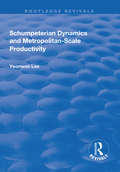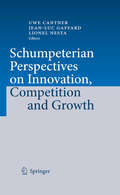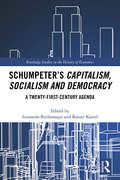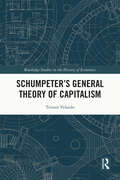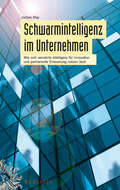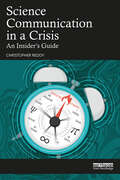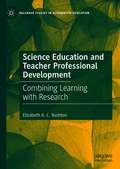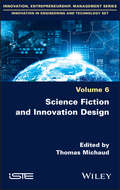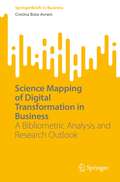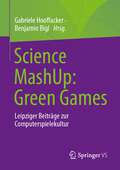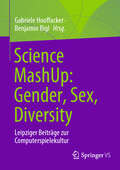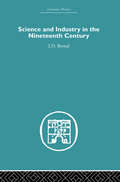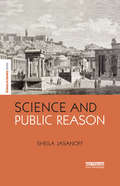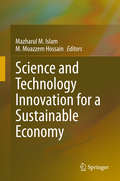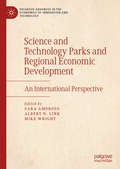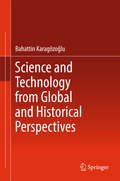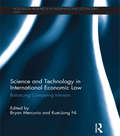- Table View
- List View
Schumpeterian Analysis of Economic Catch-up
by Keun LeeOne of the puzzles about why some countries have stronger economic growth than others revolves around the so-called 'middle-income trap', the situation in which a country that has grown strongly gets stuck at a certain level. In this book, Keun Lee explores the reasons why examples of successful catching-up are limited and in particular, why the Asian economies, including China, have managed to move, or are moving, beyond middle-income status but economic growth has stalled in some Latin American countries. This is one of the first studies to demonstrate using patent analysis that the secret lies in innovative systems at the firm, sector and country levels which promote investment in what the author calls 'short-cycle' technologies and thereby create a new path different from that of forerunning countries. With its comprehensive policy framework for development as well as useful quantitative methods, this is essential reading for academic researchers and practitioners.
Schumpeterian Dynamics and Metropolitan-Scale Productivity (Routledge Revivals Ser.)
by Yeonwoo LeeThis title was first published in 2003. Schumpeter first put forward the premise that the incessant turbulence of an economy in motion, carrying out new combinations of products, production methods with new technologies and the opening of new markets, is capable of explaining patterns of economic growth and change. Focusing on US industrialized urban areas, this volume tests this theory empirically. Localized employment ’churn’ - registered as job creation/destruction dynamics - is used to account for variations in US metro-regional economic productivity performances during the 1986-1999 period. The results suggest that the employment turnover and replacement dynamics have large and significant positive effects on localized productivity growth independent of a variety of industrial restructuring processes occurring simultaneously. While employment churn effects are robust across US Census regions, they do not exert a uniform influence on metro-regional productivity performances across time. Until 1996, job creation and destruction dynamics often cancelled each other out as metro-regions underwent continued industrial restructuring. Since 1996, however, positive effects on metro-region productivity growth have been consistently strong. In addition to a strong positive effect on productivity of the emergence of a localized IT sector, both an expanding service sector share of regional employment and a rising public spending share of regional output exert powerful downward pressure of localized productivity growth rates.
Schumpeterian Perspectives on Innovation, Competition and Growth
by Uwe Cantner Lionel Nesta Jean-Luc GaffardRecent developments in economics have gone from the recognition of the importance of innovation for growth and the exploration of innovation mechanisms to the incorporation of the results of the previous research into economic models. An important lesson to be drawn from all this research is that a purely macro-based analysis of growth is not enough. The various mechanisms of innovation creation and diffusion, the importance of agent heterogeneity, of market selection processes, of the internal organization of the firm and of organizational routines, and the obsolescence and the consequent emergence of new types of capital goods are a few examples of micro-economic phenomena that contribute decisively to macro-economic development. The papers in this volume approach those issues from a Schumpeterian point of view and tackle issues like the growing importance of knowledge and human capital; increasing returns and path dependence; the role of variety in economic growth; competition and industry evolution.
Schumpeter’s Capitalism, Socialism and Democracy: A Twenty-First Century Agenda (Routledge Studies in the History of Economics)
by Rainer Kattel Leonardo Burlamaqui2017 marked the seventy-fifth anniversary of Schumpeter’s Capitalism, Socialism and Democracy, a work acknowledged as one of the most insightful books written in the twentieth century. It retains a contemporary quality, and still invites criticisms, new interpretations, and extensions and across disciplines. This book, in addition to re-examining Schumpeter’s seminal work and undertaking a twenty-first-century update of its main themes, brings together leading social scientists to provide contemporary amendments, extensions – or eventually refutations – of key elements of Schumpeter’s vision and thesis. Issues covered include a new take on creative destruction, the contours of a theory of innovative enterprise, finance and financialisation, a critique of the secular stagnation thesis, Schumpeter’s contributions to a theory of the entrepreneurial state, his conception of socialism and its current relevance for understanding the 'China model' as well as a rekindling of his democracy thesis for our times. Bringing together leading international contributors, this book provides fresh perspectives on ideas that continue to be hugely relevant to contemporary social sciences and a guide for understanding the current tensions among capitalism, the state and democracy. These chapters will be of interest to economists, social scientists and anyone with an interest in modern capitalism.
Schumpeter’s General Theory of Capitalism (Routledge Studies in the History of Economics)
by Tristan VelardoJoseph A. Schumpeter made multiple contributions to economic science and beyond. Drawing on this wide range of writings, this book argues that Schumpeter provided a theoretical account of capitalism as a total phenomenon. It methodically reconstructs the “general theory” of capitalism present in Schumpeter's work and shows its consistency and limits. The book identifies three key dimensions of a Schumpeterian general theory of capitalism. First, capitalism is defined at its core as a form or method of economic change: the entrepreneur disrupts a static, equilibrium economy (which is the foundation of all economic activities) with the introduction of an innovation. He is an unbalancing and disruptive force. Second, capitalism is defined as an institutional order composed of private property, private initiative for private profit and credit. Finally, capitalism is defined as a "civilization" or culture: a set of values, attitudes, and beliefs. The general theory thus accounts for capitalism as an economic form (innovation and entrepreneurship) which is the source of economic change; supported and enabled by a particular institutional order without which innovation would remain a dead letter (private property, private profit, and credit); all this generates the culture of capitalism. This book will be of interest to readers in the history of economic thought, economic theory, innovation, political economy, and social theory.
Schuster's & Gimbels: Milwaukee's Beloved Department Stores (Landmarks)
by Paul GeenenA nostalgic journey into the life of these Wisconsin shopping meccas—including photos and illustrations. For well over a century, Milwaukee shoppers have had Gimbels or Schuster&’s in their lives. Even if they didn&’t crave sewing notions or prize-winning apple pies, they were watching holiday parades wind by, tuning in for Billie the Brownie&’s radio updates, or losing themselves in front of one of the department stores&’ fabulous window displays. Not only were they magical places to shop but also wonderful places to work, creating the kind of community where a kid might come in to help out with the Christmas rush and stay for twenty-five years. Enjoy this loving trip through the history of these beloved stores, from their arrival in Milwaukee in the 1880s through the 1962 merger and beyond.
Schutz genetischer, medizinischer und sozialer Daten als multidisziplinäre Aufgabe
by Stefan Katzenbeisser Kay Hamacher Heribert M. AnzingerFortschritte in der Medizin, in der Genomforschung und in der Informationstechnik stellen den Datenschutz vor ein Dilemma: Forschung und die Anwendung neuer Methoden setzen häufig voraus, dass personenbezogene Daten in großem Umfang zentral verfügbar, verteilbar und verknüpfbar sind. Gleichzeitig bergen zentrale Datensammlungen und die unübersehbare Weitergabe und Verknüpfung sensitiver Daten die Gefahr, dass der Einzelne auf ein Datenraster reduziert wird und Selbstbestimmungsmöglichkeiten verliert. Den Wertungskonflikten und der Schutzbedürftigkeit und Schutzfähigkeit personenbezogener genetischer, medizinischer und sozialer Daten widmete sich eine multidisziplinäre Veranstaltungsreihe des Center for Advanced Security Research Darmstadt, der Darmstädter Juristischen Gesellschaft und der Fakultät für Rechts- und Wirtschaftswissenschaften der Technischen Universität Darmstadt. Der vorliegende Band fasst die dabei entwickelten Gedanken verschiedener Wissenschaftsdisziplinen zusammen.
Schutzkonzepte gegen sexualisierte Gewalt in medizinischen Einrichtungen für Kinder und Jugendliche
by Jörg M. Fegert Ulrike Hoffmann Elisa König Marc Allroggen Miriam RassenhoferMedizinische Einrichtungen sind Orte, die der Pflege bei und Behandlung von Erkrankungen dienen, an denen es aber auch zu Gewalt und Vernachlässigung gegen Patientinnen und Patienten kommen kann. Seit November 2020 ist es deshalb aufgrund einer Vorgabe des Gemeinsamen Bundesausschusses (G-BA) für medizinische Einrichtungen verpflichtend, ein Schutzkonzept gegen (sexualisierte) Gewalt zu entwickeln. Für die Entwicklung von Schutzkonzepten im medizinisch-therapeutischen Bereich gab es bisher kaum umfassende Handreichungen. Das vorliegende Buch schließt diese Lücke: Die Autorinnen und Autoren gehen zunächst auf die spezifischen Merkmale des medizinisch-therapeutischen Arbeitskontextes ein und geben generelle Hinweise zur Entwicklung von Schutzkonzepten. Anschließend stellen sie die Elemente eines Schutzkonzeptes vor und geben praxisnahe Empfehlungen für dessen Entwicklung, Umsetzung und Evaluation. Zu jedem Element regen ergänzende Arbeitsblätter mit Übungen und Reflexionen zur Umsetzung in der eigenen Institution an. Darüber hinaus werden jeweils auch Hinweise zur Adaption an verschiedene Settings gegeben: den kinder- und jugendpsychiatrischen und somatischen Bereich, stationäre oder ambulante Strukturen sowie die Übertragung auf andere Zielgruppen (z.B. die Betreuung von Menschen mit Behinderung). Darstellungen von Schutzprozessen in verschiedenen Kliniken machen als Praxisbeispiele deutlich, dass es nicht den einen “Königsweg” zum Schutzkonzept gibt.Das Buch versteht sich als Praxishandbuch und richtet sich an Ärztinnen und Ärzte, Therapeutinnen und Therapeuten sowie alle anderen Fachkräfte im medizinisch-therapeutischen Bereich, die Schutzmaßnahmen entwickeln möchten - damit Kliniken und Praxen Schutzorte bleiben, statt zum Tatort zu werden.
Schwarmintelligenz im Unternehmen: Wie sich vernetzte Intelligenz für Innovation und permanente Erneuerung nutzen lässt
by Jochen May"Der Autor zeigt nicht nur auf, wie sich Schwarmintelligenz entfaltet, er gibt auch ein praxisnahes Konzept für ihre gelungenen Umsetzung im Arbeitsalltag - klar durchdacht und prägnant ausformuliert." Michael Best, Hessischer Rundfunk, ARD-Börsenredaktion Schwarmintelligenz fasziniert durch erstaunliche Ergebnisse - doch kaum ein Unternehmen hat bisher ihr außergewöhnliches Potenzial entdeckt, geschweige denn von ihr profitiert. Erst ganz allmählich gerät Schwarmintelligenz ins Blickfeld neugieriger Führungskräfte. Das liegt sicher auch daran, dass innerbetriebliche Führungsinstrumente zur Aktivierung von Schwarmintelligenz bis dato nicht zur Verfügung standen. Schwarmintelligenz beruht auf geschickter Vernetzung unterschiedlicher Kompetenzen der Schwarmmitglieder. Komplexe Sachverhalte erscheinen unter vielen Blickwinkeln und werden dadurch treffender erfasst. Entrepreneurship hält Einzug, MitarbeiterInnen erproben das Neue. Der Innovationsdruck von außen wird durch einen inneren Innovationsmotor ergänzt. Leistungen gelingen kundengerechter, die Arbeitseffizienz steigt, Reaktionszeiten verkürzen sich. Reibungsverluste werden eliminiert, Bürokratie und Verwaltungsmentalität nehmen ab. Dieses Buch stellt - zum Teil erstmalig und exklusiv - die für den betrieblichen Einsatz von Schwarmintelligenz erforderlichen Führungsinstrumente vor. Es untersucht Vorteile und Wirkungsweise von Schwarmintelligenz und weist einen leicht gangbaren, praxisorientierten Weg, Schwarmintelligenz erfolgreich in Unternehmen einzubinden. Die Techniken und Methoden sind umfassend beschrieben und erlauben es, kontinuierliche Innovation durch Schwarmintelligenz im Arbeitsalltag sofort und unkompliziert umzusetzen. Für Führungskräfte aller Ebenen und Fachrichtungen ist das Buch ein Muss, aber auch für Nachwuchskräfte und alle MitarbeiterInnen, die zukunftsorientiert verändern wollen.
Schwellenkonzeptorientierte Entrepreneurship Education: Ein wirtschaftsdidaktischer Ansatz unter Berücksichtigung komplexitätswissenschaftlicher Theorien und Methoden (Komplexität, Entrepreneurship und Ökonomische Bildung)
by Jan-Martin GeigerEntrepreneurship Education gewinnt nach wie vor an Bedeutung innerhalb der Bildungslandschaft, allen voran an Schulen und Hochschulen. Vor diesem Hintergrund besteht ein dringender Bedarf an konzeptionellen Überlegungen, die auf lerntheoretische und didaktische Fragestellungen zielen und sowohl die Theorie- als auch die Praxisebene von Entrepreneurship Education bereichern sollen. Die vorliegende Arbeit entwickelt unter Einbezug des Schwellenkonzeptansatzes eine neue Perspektive für eine wirtschaftsdidaktisch gedachte Entrepreneurship Education, die disziplinäre Phänomene mit der subjektiven Sichtweise Lernender zunächst auf theoretischer Ebene verbindet und anschließend anhand von eigens entwickelten Lernstudien empirisch untersucht.
Schwierige Situationen im Business-Coaching: Praxisbeispiele, Perspektiven und Handlungsmöglichkeiten
by Heidi Möller Jannik ZimmermannCoaches begegnen in ihrer beruflichen Praxis einer Bandbreite von Situationen, die sie als schwierig erleben. Die Herausforderungen haben unterschiedliche Quellen. Sie können von den Coaches selbst, den Coachees oder der beauftragenden Organisation ausgehen. Doch wie stellen sich diese Situationen im Detail dar? Wie kann man als Coach diese verstehen und angemessen darauf reagieren? Anhand online erhobener realer Fallbeispiele werden in diesem Buch schwierige Situationen genauer betrachtet. Hierbei stellen renommierte Coaches ihre theoretischen und methodischen Perspektiven und ihre Handlungsempfehlungen zur Diskussion.
Science Communication in a Crisis: An Insider's Guide
by Christopher ReddyScience Communication in a Crisis: An Insider’s Guide identifies the principal challenges that scientists face when communicating with different stakeholder groups and offers advice on how to navigate the maze of competing interests and deliver actionable science when the clock is ticking. If a scientist’s goal is to deliver content and expertise to the people who need it, then other stakeholder groups—the media, the government, industry—need to be considered as partners to collaborate with in order to solve problems. Written by established scientist Christopher Reddy, who has been on the front lines of several environmental crisis events, the book highlights ten specific challenges and reflects on mistakes made and lessons learned. Reddy’s aim is not to teach scientists how to ace an interview or craft a soundbite, rather, through exploring several high-profile case studies, including the North Cape oil spill, Deepwater Horizon, and the 2021 Sri Lanka shipping disaster, he presents a clear pathway to effective and collaborative communication. This book will be a great resource for junior and established scientists who want to make an impact, as well as students in courses such as environmental and science communication.
Science Education and Teacher Professional Development: Combining Learning with Research (Palgrave Studies in Alternative Education)
by Elizabeth A. C. RushtonThis book presents a radical reconceptualization of subject-focused and research-led teacher professional development. Drawing on the experiences of more than 50 high school teachers and technicians who participated in science-based research with their students, the author examines how this enables teachers to develop a ‘Teacher Scientist’ model of professional identity. Through active participation in research, science teachers and technicians can implement socially just approaches to education, where students’ differences are valued and, through research, their social and academic development is supported. Central to the ‘Teacher Scientist’ identity is the development of, and sustained interaction with, complex and collaborative professional networks which include researchers, university-staff and teachers and students in other schools. In the context of persistent recruitment and retention challenges, the ‘Teacher Scientist’ model provides a research-led approach which may offer an alternative to strategies focused on financial incentives.
Science Fiction and Innovation Design
by Thomas MichaudScience fiction is often presented as a source of utopia, or even of prophecies, used in capitalism to promote social, political and technoscientific innovations. Science Fiction and Innovation Design assesses the validity of this approach by exploring the impact this imaginary world has on the creativity of engineers and researchers. Companies seek to anticipate and predict the future through approaches such as design fiction: mobilizing representations of science fiction to create prototypes and develop scenarios relevant to organizational strategy. The conquest of Mars or the weapons of the future are examples developed by authors to demonstrate how design innovation involves continuous dialogue between multiple players, from the scientist to the manager, through to the designers and the science fiction writers.
Science Fiction and Organization (Routledge Studies in Human Resource Development #No.2)
by Martin Parker Matthew Higgins Warren Smith Geoff LightfootScience fiction can be seen as a diagnosis of the present, and a vision of possible futures. It therefore provides an excellent resource with which to interrogate both contemporary organizing processes and organizations as institutions. The marginal activity of science fiction has, however, been largely ignored in writing on organization theory. This international collection is the first book of its kind to explore how science fiction can enrich studies of organization by drawing on perspectives across the arts and social sciences.
Science Mapping of Digital Transformation in Business: A Bibliometric Analysis and Research Outlook (SpringerBriefs in Business)
by Cristina Bota-AvramDigital transformation will affect every company or organization sooner or later, regardless of the industry, country, or type of organization. In recent years, this impact has become disruptive, and there is an increasing need for companies to innovate their business models while using various emerging technologies. The key goals of this book are twofold. The first goal is to provide a comprehensive overview of the state of digital transformation in business using various bibliometric indicators, while the second goal is to propose a synthesis of the potential directions and opportunities for future research agenda related to this field of research. The bibliometric analysis of the current state of knowledge published in the field of digital transformation in business over the last 20 years reveals the existence of four major thematic clusters: (1) the digital transformation process, (2) digital technologies, (3) the digital economy, and (4) digital disruption. Based on the content analysis of the most important articles that belonged to each cluster of topics, the book outlines several directions for future research. This makes it a useful resource for researchers interested in the field of digital transformation in business.
Science MashUp: Leipziger Beiträge zur Computerspielekultur
by Gabriele Hooffacker Benjamin BiglDer Band zum Science MashUp Green Games umfasst wissenschaftliche Beiträge zum Thema "Green Games". Das Tagungsthema „Green Games“ zielt auf Ökologie und Nachhaltigkeit von Computerspielen in Bezug auf Spielinhalte sowie in Bezug auf soziale, kulturelle oder technische Aspekte ab. Der Band umfasst zehn Beiträge. Themen sind Aspekte der Nachhaltigkeit in der Produktion, Umsetzung, Zielsetzung und Vermarktung von Games.
Science MashUp: Leipziger Beiträge zur Computerspielekultur
by Gabriele Hooffacker Benjamin BiglDas diesjährige Motto – Gender, Sex, Diversity – der vierten Ausgabe der Reihe Science MashUp greift aktuelle politische und gesellschaftliche Debatten ebenso auf wie inhaltliche und technische Entwicklungen im Games-Bereich. Der Band fasst die Tagung im Rahmen der 17. Langen Nacht der Computerspiele sowie weitere Abschlussarbeiten an der Hochschule für Technik, Wirtschaft und Kultur Leipzig (HTWK Leipzig) zusammen. Themen sind die Darstellung und das Identifikationspotenzial von Held*innen in Games, feministisches und barrierearmes Design von Games, inhaltliche und konzeptionelle Analysen von Geschlechter- und Beziehungsrollen in Games, Intersektionalität in Games sowie Grenzüberschreitungen von und mit Games.
Science Technology Co.--1985
by Thomas R. PiperThe CEO of a U.S. electronics firm is assessing the financial forecasts and the financing plan prepared by the chief financial officer. Given the cyclicality of the industry and the volatility of the firm's performance, the CEO is unsure as to the usefulness of forecasts based on straight line extrapolation of rapid sales growth and stable relationships of profits and assets to sales. The teaching objectives include: 1) how many years into the future should the forecasts run given the level of uncertainty, 2) how can one deal with the high uncertainty when preparing the forecasts or designing a financing plan, and 3) how to estimate the financing needs under conditions of adversity.
Science and Industry in the Nineteenth Century
by J.D. BernalPublished in 2005, Science and Industry in the Nineteenth Century is a valuable contribution to the field of Economic History.
Science and Public Reason (The Earthscan Science in Society Series)
by Sheila JasanoffThis collection of essays by Sheila Jasanoff explores how democratic governments construct public reason, that is, the forms of evidence and argument used in making state decisions accountable to citizens. The term public reason as used here is not simply a matter of deploying principled arguments that respect the norms of democratic deliberation. Jasanoff investigates what states do in practice when they claim to be reasoning in the public interest. Reason, from this perspective, comprises the institutional practices, discourses, techniques and instruments through which governments claim legitimacy in an era of potentially unbounded risks—physical, political, and moral. Those legitimating efforts, in turn, depend on citizens’ acceptance of the forms of reasoning that governments offer. Included here therefore is an inquiry into the conditions that lead citizens of democratic societies to accept policy justification as being reasonable. These modes of public knowing, or “civic epistemologies,” are integral to the constitution of contemporary political cultures. Methodologically, the book is grounded in the field of Science and Technology Studies (STS). It uses in-depth qualitative studies of legal and political practices to shed light on divergent cross-cultural constructions of public reason and the reasoning political subject. The collection as a whole contributes to democratic theory, legal studies, comparative politics, geography, and ethnographies of modernity, as well as STS.
Science and Technology Innovation for a Sustainable Economy
by Mazharul M. Islam M. Moazzem HossainThis book discusses the subject of pathways to a sustainable economy through science and technology innovations which are regarded as the important components of the ‘4th Industrial Revolution’. The volume has been developed from Bangladesh’s ‘Vision 2041’ agenda which includes development actions needed to catch up with more developed nations. Most importantly, the goals of the ‘Vision 2041’ have been taken from the dreams of the architect of independent Bangladesh, Bangabandhu (Friends of Bengal) Sheikh Mujibur Rahman. His dream was to make Bangladesh the Switzerland of Asia. The Father of Bangladesh Nation was killed by assassins’ bullets along with his most of the family members in August 1975. After his death, the nation moved backwards while recovering from nine months of liberation post war in 1971.Between 1975 and 1990 Bangladesh was ruled by military and quasi military governments. Bangladesh established a true democratic regime in 1996 with Sheikh Mujib’s daughter, Sheikh Hasina, who formed the government after 21 years with a mandate to realise the dreams of her father. Sheikh Hasina, had her own 20 year vision for Bangladesh, called, ‘Vision 2021’, with plans to make the nation poverty free by 2021. After a pause between 2001 and 2008, Sheikh Hasina returned to power in 2009. Under her consecutive three terms she brought Bangladesh back on track and Bangladesh is one of the nations which reduced poverty half under MDGs by 2015. During her third consecutive term Sheikh Hasina, is on the way to transforming Bangladesh into a ‘middle income’ nation by 2021. This volume aims to identify and mitigate the challenges of ‘4th Industrial Revolution’ investigating the areas of science and technology innovations for Bangladesh and for other parts of the world keeping in mind establishing a sustainable economy under UN agendas to 2030 (SDGs). The primary audience for this book are UN development agencies, academic institutions, government policymakers and business leaders of the more developed and developing nations alike.
Science and Technology Parks and Regional Economic Development: An International Perspective (Palgrave Advances in the Economics of Innovation and Technology)
by Mike Wright Albert N. Link Sara AmorosoThis book is the first collection of scholarly writings on science and technology parks (STPs) that has an international perspective. It explores concrete ways to systematically collect information on public and private organizations related to their support of and activities in STPs, including incubation to start-up and scale-up, and collaborations with centers of knowledge creation. Rather than perpetuate the qualitative assessment of successful practices, the focus of this book is to present quantitative and qualitative evidence of the impact of STPs on regional development and to raise awareness on the importance of systematic data collection and analysis. Only through a systematic collection of data on fiscal identification numbers of companies, universities, and university spin-offs will it be possible to conduct current and especially future analyses on the impact of STPs on entrepreneurship, effectiveness of technology transfer, and regional economic development. To this extent, the synergistic views of academics, representatives from STPs, and policy experts are crucial.
Science and Technology from Global and Historical Perspectives
by Bahattin KaragözoğluThis book provides science and technology ethos to a literate person. It starts with a rather detailed treatment of basic concepts in human values, educational status and domains of education, development of science and technology and their contributions to the welfare of society. It describes ways and means of scientific progresses and technological advancements with their historical perspectives including scientific viewpoints of contributing scientists and technologists. The technical, social, and cultural dimensions are surveyed in relation to acquisition and application of science, and advantages and hindrances of technological developments. Science and Technology is currently taught as a college course in many universities with the intention to introduce topics from a global historical perspective so that the reader shall stretch his/her vision by mapping the past to the future. The book can also serve as a primary reference for such courses.
Science and Technology in International Economic Law: Balancing Competing Interests (Routledge Research in International Economic Law)
by Bryan Mercurio Kuei-Jung NiScience and technology plays an increasingly important role in the continued development of international economic law. This book brings together well-known and rising scholars to explore the status and interaction of science, technology and international economic law. The book reviews the place of science and technology in the development of international economic law with a view to ensure a balance between the promotion of trade and investment liberalisation and decision-making based on a sound scientific process without hampering technological development. The book features chapters from a range of experts – including Lukasz Gruszczynski, Jürgen Kurtz, Andrew Mitchell and Peter K. Yu – who examine a wide range of issues such as investment law, international trade law, and international intellectual property. By bringing together these issues, the book asks how international trade and investment regimes utilise science and technology, and whether they do so fairly and in the interest of broader public policies. This book will be of great interest to researchers of international economic law, health law, technology law and international intellectual property law.

